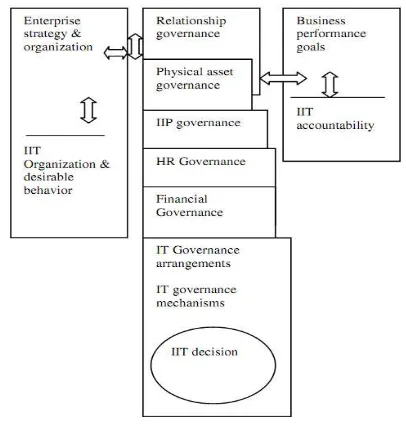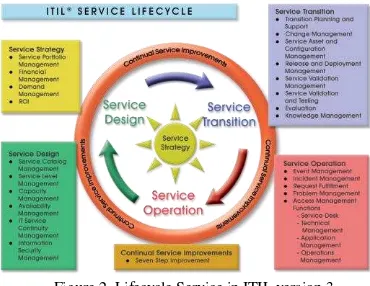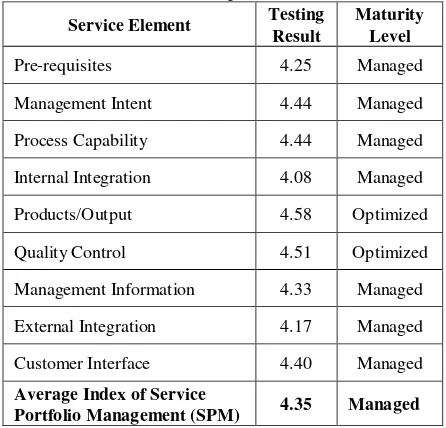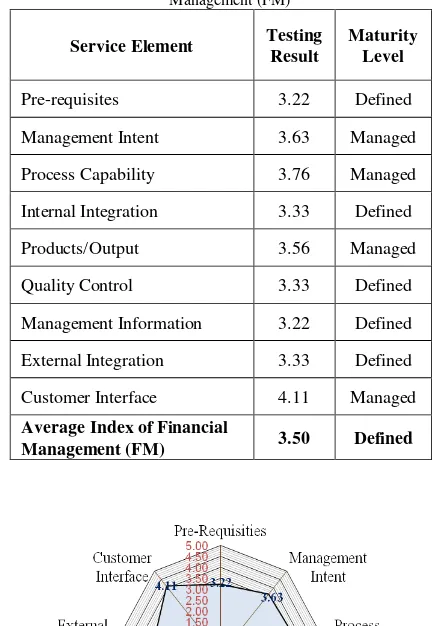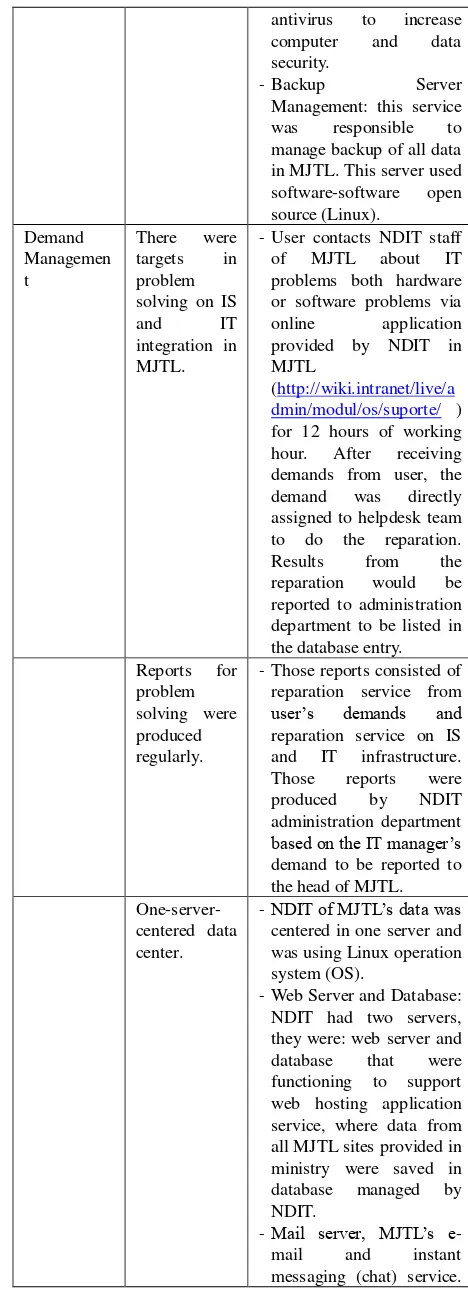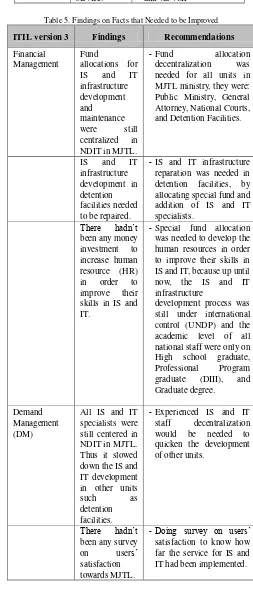Perceptions Analysis on Service Delivery (SD) using ITIL
version 3 framework in Ministerio Da Justica Ministry
Dili Timor Leste
Edio da Costa1, Prof. Dr. Ir. Eko Sediyono, M.Kom2 and Marwata, Ph.D., Akt 3
1
Faculty of Information Technology Satya Wacana Christian University
Diponegoro 52-60 Street, Salatiga 5011, Central of Java, Indonesia
2
Departemen Master of Information Systems Satya Wacana Christian University
Diponegoro 52-60 Street, Salatiga 5011, Central of Java, Indonesia
Abstract
Service Delivery (SD) is a managerial of the processes that have a primary focus on the user of all Information System (IS) and Information Technology (IT) services, which ensures that IS and IT services can be used according as the function to support the activities in the public institutions. The purpose of this study was to determine the extent to which the strategic development of IS and IT services that have been implemented in accordance with the strategic plan towards the implementation of IT Governance. The results of this study indicate that significantly the Ministerio da Justiça Dili Timor Leste (MJTL) has implemented policies and standard operation procedures (SOP) relating to the framework of Information Technology Infrastructur Library (ITIL) version 3, although it is not maximized and extended throughout the unit, it is because lack of human resources, staffing and financial aspects.
Keywords: SD, IS, IT, IT Governanc, MJTL, ITIL version 3.
1.
Introduction
Nowadays, many organizations are more dependent on Information System (IS) and Information Technology (IT) in order to achieve their strategic goals and fulfill their needs; which is why Information and Communication Technology (ICT) becomes important [1]. This dependency encourages the increasing needs of high-quality IS and IT
service that matches the user’s and organization’s needs.
High-quality IS and IT service means there are
improvement on the usage of IT to fulfill the organization’s
needs. Moreover, providing high-quality IS and IT service also means that there should be country’s utilization of IT
because developing IT in public service is also a key of a development in a country.
Timor Leste is a new country that exists in a global enviroment and it makes Timor Leste’s government must master IS and IT, which later can be implemented for the
betterment of its own people. That’s why Timor Leste
government must be more open and perceptive to utilize the IS and IT development as a tool for increasing the ability of managing, channeling, and distributing information for public service, looking at the fact that the more developed the IS and IT sector in a country is, the
more developed the country will be. That’s also the reason
why government must invest on IS and IT more. Government must also implement IS and IT in its work, and MJTL or Law Ministry Timor Leste is one of the government institutions that has implemented IS and IT in its work. MJTL is a government institution that serves public in law sector and the implementation of IS and IT in its body is able to integrate some divisions such as Public Ministry, the General Attorney, the National Court and the Detention Facilities [2]. MJTL has increased the infrastructure investment in ICT sector using national budget by upgrading the service quality using IT, increasing the internet and intranet connection quality, and expanding
the network of MJTL in all Timor Leste’s districts. According to the MJTL’s strategic plan, the infrastructure
software license, tools use, warehouse, etc.; 2) SOP that is not unified and not standard, where each division has its own rules and causes troubles in applying IT Governance generally; 3) the lack of specialization because of centralization (centralized IT professionals). Based on
those problems, it’s important to do a research in order to
find out to what extent IS and IT service have been implemented.
The framework used in this research is ITIL (Information Technology Infrastructure Library) version 3. ITIL is a framework used to manage IS and IT service that is divided into process and function. There are two areas or models in ITIL, they are Service Support (SS), the one ensuring that there are IT services that can help business functions to work well, and Service Delivery (SD), the one focusing on what services needed by IT provider company so that it can give services to the user’s business. So it can be seen that ITIL is an approach in IT Governance and IT service governance [3].
This research refers to some previous researches, the first one is a research entitled Analysis on IT Management Service using ITIL Framework: A Case Study in Faculty of Information Technology Satya Wacana Christian University [4]. From this research, it was found that the development of portfolio management was more focused on needs fulfillment without considering the business value. It also happened with the request management, where there was imbalance between the income and the expenses for IT
investment. In the end, it was found that there wasn’t any
general integration in all IT services that Faculty of Information Technology Satya Wacana Christian University had. On the other side, the grand development of IT
services management hasn’t been found yet. That’s why
there needs to be an integration in services in order to fulfill the needs of IT services. The follow-up action of the grand design development can be started by integrating all IT services comprehensively.
The second is a research entitled Risk Management in Information Technology for Public Service Sustainability using ITIL version 3 framework [5]. From this research, it could be seen that the advancement of ICT and the spreading of global information infrastructure development had changed the pattern and the activity in organizations, in institutions, in industries, as well in government. Doing Risk Management in IT and having some strategies for the sustainability of IT services must be done systematically and there had to be continuous practices to improve and repair the IT services process. ITIL version 3 framework was used as a guidance in arranging operational steps so that the sustainability of IT services could be created.
What differentiates my research with the previous researches is that my research will only focus on perception analysis on service delivery in National Division of Information Technology (NDIT) in MJTL using ITIL
version 3 framework with the domain of Service Strategy (SS) and the sub domains of Service Portfolio Management (SPM), Demand Management (DM), and Financial Management (FM).
2.
Literature Review
Service Delivery is a group of managerial process that has the main focus on user of all IT services, which ensures that those IT services can be used according to their function to help business activities. Like an Internet user, it always cares for access quality, bandwidth-related issues, availability and easiness to access the Internet anytime and anywhere, the access price, and other facilities that someone can get in Internet Service Provider [6]. Service Delivery consists of:
- Service Level Management: it has the main purpose to balance the demand and supply in IT services by knowing the business needs and the capability of IT in business organizations or companies.
- Financial Management: it is the main mechanism in managing the financial resources in a company. This mechanism will support a company in planning and executing all of its business goals. It also needs a consistent and integrated application in all parts of company in order to create a maximum consistency. - Capacity Management: it is a process that is
responsible for ensuring the process or computation and storage capacity the IT has according to the business needs, which keeps on evolving, of course using effective budget and sustainable planning. - IT Services Continuity Management or Disaster
Recovery Plan (DRP): In other words, ITIL uses IT Services Continuity Management (ITSCM) for all processes that are related to IT services recovery after problems that make IT services unavailable arise - Availability Management: it is a process used for
answering the dependency of business toward IT. The main purpose of the existence of Availability Management is optimizing IT infrastructure capability and services, as well as the organizations involved in it, so that the availability in the whole IT services used in business can be ensured.
Based on the definitions above, it can be concluded that Service Delivery is one of the important components in
ITIL, that describes best practice’s processes in facing and
interacting with the business customer of IT services.
2.1. Information Technology Service Management (ITSM)
the effectiveness and efficiency in giving services to the customers [7]. The advantages of ITSM are:
- the increasing quality of service provider - the justification about fees for service quality - services that match the business and user’s demand - more centralized business process
- everyone’s knowing about their roles and responsibilities in service providing
- the ability to learn from previous experiences. - the proven performance indicator
There are four perspectives or attributes to explain the concept of ITSM, they are [8]:
- Partners or Suppliers Perspective: it considers the importance of relationship between external sides, partner, and supplier and the way they contribute in service delivery.
- People Perspective: it focuses on softer area than IT staff, customer, shareholder, etc., for example whether staff has already had ability and knowledge to carry out their roles.
- Products / Technology Perspective: it considers the roles of technology, hardware, software, and even budgeting.
- Process Perspective: it has an end-to-end relationship of service delivery based on the ongoing process.
2.2. It Governance
Basically, IT Governance is seen as a way to utilize
IT to achieve organization’s goal. That’s why the role of IT
Governance is put on the framework of IT management to
achieve organization’s goal. IT Governance can also be
seen as a process that can control a decision making and problem solving by emphasizing on integrated and systematic values.
IT Governance specifically focuses on IT system, performance, and risk management. The main purpose of IT Governance is to ensure that investment in IT results in business value and the decrease of IT-related risks. It can be done by applying a good organization structure that has roles for information responsibility, business process, application process, and infrastructure process. IT Governance is needed to ensure that investment will be successful, will decrease IT-related risks, and will avoid failure when IT is designed for making changes in an organization [9].
The survey done by IT Governance Institute (ITGI), which was included in the IT Governance Global Status Report published in 2008, said that 63% of respondents stated that IT is very important for their organizations, including organizations in Indonesia, because the survey was also done to the CIO (Chief Information Officer) and CEO (Chief Executive Officer) in Indonesia [10].
If seen from the comprehension sides, then IT Governance is seen as decisions taken to ensure the existence of allocation of IT uses in strategies in related organizations [11]. Based on the definition above, three questions that need answers are:
- What decisions must be taken in order to ensure the effectiveness and efficiency of IT management? - Who are the ones that must take decisions related to
the use of IT?
- How are those decisions taken and monitored? Referring to the questions that have been asked before, Figure 1 below shows the process that can help in understanding, designing, communicating, and taking care of IT.
Figure 1. The Effective IT Governance
Based on Figure 1, developing an effective IT Governance needs:
- Better organization’s strategy establishment.
- More concern on organizations behaviour and how IT is applied in the organization.
- Good management of six assets an organization has, such as: relationship between the Assets, physical asset, intellectual property asset, human relation asset, financial asset, and IT.
- Good organization’s strategy creation regarding to the IT use in an organization.
2.3. Information Technology Infrastructure Library (ITIL)
influences to the management, including people and process management, technology effectiveness, and the efficiency and economy in giving business services with agreed service level in IT and business.
The fact that supported the application of this ITIL framework was noted by an organization called Pink Elephant. Based on that note, some consultant organizations or international surveys has surveyed business actors about the application of ITIL in their companies. Here are some of the survey results:
- In Gartner Survey in 2004, the amount of the respondents that said that they used ITIL in their companies was 30% higher than the amount of the respondents who said so in 2003.
- Based on the Oline Polling Week to 450 IT professionals about the use of ITIL, there were 50% of them who had passed the planning phase or were going to start this phase in six or twelve months, whereas 30% of them had implemented ITIL effectively.
Based on the survey result, it was proven that more organizations / companies started to apply ITIL framework to improve their performances and gain benefits.
The last version of ITIL is version 3. The basic change in this version is in how it sees the IT management; ITIL version 2 manages its service as a group of processes and functions, whereas ITIL version 3 manages its service as a lifecycle. From Figure 2, we can see a cycle that emphasizes on lifecycle. The Figure shows that the steps emphasize on needs analysis process in designing, delivering, and strengthening the service for customers [12].
Figure 2. Lifecycle Service in ITIL version 3
Service Strategy gives guidance for those who implement ITSM about how to understand the concept of
ITSM. It’s not only organization’s ability (in giving, managing, as well as operating IT services), but also
company’s strategic asset. Service strategy is more focused
on skills development for service management, which enables this practice to be strategic asset of an
organization. This guidance is given in the form of basic principles of ITSM concept, references, and core processes that operate in ITIL Service Lifecycle steps [12].
Service Design: In order for IT services can give benefits to business organizations, first thing first, they have to be designed based on business’ purpose from customers. Service Design gives guidance to IT organizations to design and develop IT services as well as to implement ITSM systematically [12]. Service design is a phase when the process of designing the infrastructure and supporting mechanism happens, which is needed to get the needs that the customers want. Service design phase
emphasizes on wanted or needed IT services’ design.
Service Design contains design principles and methods to
convert IT organizations’ and business’ strategic goals into IT services’ portfolio / collection and service’s assets like
server, storage, etc.
Service Transition provides guidance to IT organizations to develop the skills used to change IT
services’ design as well as IT services whose specifications have been changed into operational environment [12]. This lifecycle step shows how a need, which is described in Service Strategy, is formed in Service Design to be realized later into Service Operation effectively.
Service Operation is a lifecycle step that covers all operational activities in IT services management. There is much guidance inside it about how to manage IT services efficiently and effectively and how to guarantee the
performance’s level so that it can satisfy the customers
[12]. This guidance covers about how to maintain the operational stability of IT services and also design change
management, scale, coverage, and IT services’ performance
target.
Continual Service Improvement (CSI) gives important guidance in arranging and maintaining the service quality of the design process, transition and its operational activities. CSI combines various principles and methods from quality management, for example Plan-Do-Check-Act (PDCA) or Deming Quality Cycle [12].
3.
Research Methodology
Ad-Hoc 1.00
Repeatable 2.00
Defined 3.00
Managed 4.00
1.50 2.50 3.50 4.50
Optimized 5.00
Figure 3. Research Methodology
Questionnaire Distribution It was done in this research by distributing questionnaire or list of questions or statements to the respondents in order to get primary data according to the request using likert scale. There were 18 respondents in this research, they are: IT Manager, IT International Manager, International System Analyst, sys admin, database admin, help desk, network administrator, front office system, ICT trainer, and Administration Assistant.
4.
Analysis Result of Maturity Level in NDIT
in MJTL
4.1. Service Strategic Analysis Sub Domain Service Portfolio Management (SPM)
This process is one of the dynamic processes that develops continuously, including the methods used to achieve the long-term and short-term goal in NDIT about IS and IT which has been implemented in MJTL. The resources used was human resources and adequate technology to give service to the user.
The questionnaire and interview result and data analysis is shown in the form of Likert Questionnaire, where the result for every question in service element is added and divided by 18 respondents. The result for every service element can be seen in the second column (Testing Result) in Table 1. All testing results can be added so that we get the Service Portfolio Management (SPM) average index score of 4.35, the round figures is 4.00. Based on the range of 1-5 according to the guidelines of ITIL version 3 in domain Service Strategic (SS), sub domain Service Portfolio Management (SPM), the position in MJTL is at 4: Managed.
Figure 4. Maturity Level in Sub Domain Service Portfolio Management (SPM) in MJTL
From the analysis on Figure 4, it can be concluded
that although NDIT in MJTL hadn’t implemented the
service standard using ITIL framework to the user, NDIT had implemented the methodologies in sub domain Service Portfolio Management (SPM) in developing short-term and long-term strategies toward IS and IT services which had been included in Standard Operation Procedure (SOP) to achieve the goals and vision and mission of NDIT in MJTL. According to the manager of NDIT in MJTL, that strategy hadn’t been spread to all units because of the minimum number of human and financial resources that were used to invest in IS and IT infrastructure development. If it was connected to the real condition in MJTL, a finding showed that the service implemented in NDIT in MJTL was a report about IS and IT services which was produced and reported periodically. Besides that, all staffs that were responsible to give the service to IS and IT activities had been trained although their academic knowledge needed to be improved. The result from every service element and Maturity Level can be seen in Table 1 and Figure 5.
Table 1. Maturity Level Analysis in Sub Domain Service Portfolio Management
Service Element Testing Result
Maturity Level
Pre-requisites 4.25 Managed
Management Intent 4.44 Managed
Process Capability 4.44 Managed
Internal Integration 4.08 Managed
Products/Output 4.58 Optimized
Quality Control 4.51 Optimized
Management Information 4.33 Managed
External Integration 4.17 Managed
Customer Interface 4.40 Managed
Average Index of Service
Portfolio Management (SPM) 4.35 Managed Analysis based on the criteria of
ITIL version 3
Findings and Recommendation Assessment based on Maturity Level in ITIL version 3 framework Data Gathering:
- Observation
Ad-Hoc 1.00
Repeatable 2.00
Defined 3.00
Managed 4.00
1.50 2.50 3.50 4.50
Optimized 5.00 Figure 5. Representative of Analysis Result in Sub Domain Service
Portfolio Management (SPM)
4.2. Service Strategic (SS) Analysis in Sub Domain Demand Management (DM)
This process is a strategy done by NDIT in MJTL by arranging the mechanism to give service to users about IS and IT that have been implemented. The questionnaire and interview result and data analysis is shown in the form of Likert Questionnaire, where the result for every question in service element is added and divided by 18 respondents. The result for every service element can be seen in the second column (Testing Result) in Table 2. All testing results can be added so that we get the Demand Management (DM) average index score of 4.29, the round figures is 4.00. Based on the range of 1-5 according to the guidelines of ITIL version 3 in domain Service Strategic (SS), sub domain Demand Management (DM), the position in MJTL is at 4: Managed.
Figure 6. Maturity Level in Sub Domain Demand Management (DM) in MJTL
From the analysis on Figure 6, it can be concluded
that although NDIT in MJTL hadn’t implemented the
service standard using ITIL framework to the user, they had implemented the service methodology Demand Management (DM) in arranging the service capacity
toward user’s request. Figure 6 shows that the Maturity Level is at 4 (Managed). It means that the service arrangement had been documented and communicated in
MJTL although it hadn’t used its maximum effort in
applying the rules in SOP. That’s why it’s very important
that MJTL, especially NDIT, improve the service capacity by improving the quality of human resources, for example through trainings, SOP socialization, review about internal rules that had been standardized and budget investment, and the application of methodologies based on ITIL standard so that IT Governance can be applied. The result from every service element and Maturity Level can be seen in Table 2 and Figure 7.
Table 2. Maturity Level Analysis in Sub Domain Demand Management (DM)
Service Element Testing Result
Maturity Level
Pre-requisites 4.35 Managed
Management Intent 4.17 Managed
Process Capability 4.56 Optimized
Internal Integration 4.24 Managed
Products/Output 4.27 Managed
Quality Control 4.42 Managed
Management Information 4.41 Managed
External Integration 3.89 Managed
Customer Interface 4.32 Managed
Average Index of Demand
Management (DM) 4.29 Managed
Figure 7. Representative of Analysis Result in Sub Domain Demand Management (DM)
Ad-Hoc 1.00
Repeatable 2.00
Defined 3.00
Managed 4.00
1.50 2.50 3.50 4.50
Optimized 5.00 The questionnaire and interview result and data analysis is shown in the form of Likert Questionnaire, where the result for every question in service element is added and divided by 18 respondents. The result for every service element can be seen in the second column (Testing Result) in Table 3. All testing results can be added so that we get the Financial Management (FM) average index score of 3.50, the round figures is 3.00. Based on the range of 1-5 according to the guidelines of ITIL version 3 in domain Service Strategic (SS), sub domain Financial Management (FM), the position in MJTL is at 3: Defined.
Figure 8. Maturity Level in Sub Domain Financial Management (FM) in MJTL
From the analysis on Figure 8, it can be concluded that NDIT in MJTL had implemented the methodology of Financial Management (FM) in giving financial service to
IS and IT in MJTL. However, the service hadn’t shown its
maximum performance and it hadn’t spread to all units in
the ministry so the IT development in some units hadn’t
worked maximally. Figure 8 shows that the Maturity Level is at 3 (Defined). It means that the financial condition for service toward IS and IT infrastructure as well as the human resources development was not really good enough
and hadn’t spread to all units in MJTL. Besides that, MJTL, especially NDIT, hadn’t had the clear procedure to
provide IT facilities. Based on the analysis on the interview with NDIT manager, it was found that so far, the leader of
the ministry hadn’t invested special budget to improve the
quality of the human resources in academic sector. Besides that, the budget allocation to develop IS and IT was still centralized that made the development processes in some units or divisions obstructed. That’s why, it’s very important that the leader of the ministry allocate special budget to improve the quality of human resources. Moreover, the budget has to be decentralized for each unit so that IS and IT service can be given and the best practices in ITIL version 3 can be implemented to achieve the IT Governance. The result from every service element and Maturity Level can be seen in Table 3 and Figure 9.
Table 3. Maturity Level Analysis in Sub Domain Financial Management (FM)
Service Element Testing Result
Maturity Level
Pre-requisites 3.22 Defined
Management Intent 3.63 Managed
Process Capability 3.76 Managed
Internal Integration 3.33 Defined
Products/Output 3.56 Managed
Quality Control 3.33 Defined
Management Information 3.22 Defined
External Integration 3.33 Defined
Customer Interface 4.11 Managed
Average Index of Financial
Management (FM) 3.50 Defined
Figure 9. Representative of Analysis Result in Sub Domain Financial Management (FM)
4.4. Findings of IS and IT Services in NDIT in MJTL
Table 4. Appropriateness of ITIL version 3 in MJTL
ITIL
version 3 Findings Activities Service about IT infrastructure, network, and free software making web applications
by using content particular, did weekly meeting with all IS and IT staff to discuss and analyze the development of each activity done by
- Firewall, to increase user’s
safety and system’s safety. IP service automatically for all users in MJTL in giving security while accessing the internet via connected computers in MJTL’s network will give the designated IP address (100-700).
- Anti-virus server: NDIT used centered antivirus
server (Symantec
Endpoint) that managed each computer in MJTL, which also functioned as anti-spyware firewall and external problems. After the antivirus was installed in client’s computer, this
server would
automatically updates
antivirus to increase
computer and data
security.
- Backup Server
Management: this service
was responsible to
manage backup of all data in MJTL. This server used software-software open
problems both hardware or software problems via hour. After receiving demands from user, the
reported to administration department to be listed in
- Those reports consisted of reparation service from
user’s demands and
reparation service on IS and IT infrastructure.
Those reports were
produced by NDIT
administration department based on the IT manager’s demand to be reported to
centered in one server and was using Linux operation system (OS).
- Web Server and Database: NDIT had two servers, they were: web server and
database that were
functioning to support web hosting application service, where data from all MJTL sites provided in ministry were saved in
database managed by
NDIT.
- Mail server, MJTL’s e
-mail and instant
This technical team was This server constantly collected statistics on network usage for all units in MJTL, projected real-time graph which was
monitored on special
monitor in NDIT
helpdesk. With this,
helpdesk team could
detect network or server problems quickly and act fast to find the solution.
- Virtual Private Network Server (VPN): this service
managed long distance
communication via
internet between all
divisions and units in MJTL.
- Windows Server Update
Service (WSUS): this
service was used by NDIT to do centralized update on all system changes in MJTL.
- Server Virtualization, this service was used to divide
server resource into
numbers of virtual servers. Virtual servers had the ability to run operation system independently like a server. They were also able to reboot a server virtually apart (reboot without the main server). reparation service via https://wikiintranet.mktl.tl
service. and via VoIP
Table 5. Findings on Facts that Needed to be Improved
ITIL version 3 Findings Recommendations
Financial Public Ministry, General Attorney, National Courts, detention facilities, by allocating special fund and
- Special fund allocation was needed to develop the human resources in order to improve their skills in IS and IT, because up until now, the IS and IT infrastructure
development process was still under international control (UNDP) and the academic level of all national staff were only on High school graduate,
Professional Program
5.
Conclusion
Based on the analysis and research toward NDIT in MJTL, it can be concluded that:
- Research result from Strategic Service (SS) domain, Service Portfolio Management (SPM) sub domain scoring 4.36 (managed) shows that MJTL had implemented methods listed in Service Portfolio Management (SPM) in building short-term and long-term strategies toward IS and IT service which had been implemented in Standard Operation Procedure
(SOP) to reach NDIT in MJTL’s vision and mission.
However, those strategies were not maximum yet due to the lack of quality in human resources and funds for IS and IT infrastructure development. Meanwhile in Demand Management (DM) sub domain, scoring 4.29 (managed), shows that MJTL had been organizing and maintaining capacity in giving services for users. However those services were still prioritized only in some units, not widely spread to all units in MJTL because of financial and human resource factors. In Financial Management (FM) sub domain, scoring 3.50, means that financial condition for IS and IT service and human resource development was not good enough and it was not spread evenly in MJTL.
- Significantly, development process of IS and IT service in MJTL had been documented and communicated into: short-term and long-term strategies to give services towards users. MJTL had also controlled the capacity in giving services for the users and had applied best practices in ITIL version 3 program in aiming for the application of IT Governance in NDIT in MJTL. In this research, the researcher was only using Service Strategic (SS) domain, so further researches using the other 4
domains that haven’t been used here are needed.
References
[1] D. Weber, Information System and Technology. Prentice Hall, 2000.
[2] RDTL, Strategic Plan national division of information technology.Dili Timor Leste, 2010. [3] K. Mulyani, ITIL Versi 3 Fundation Exam The
Study Guide. First edition, first impression, Van Haren Publishing, Zaltbommel, 2009.
[4] D. M. Augie, Analysis on IT Management Service using ITIL Framework: A Case Study in Faculty of Information Technology Satya Wacana Christian University, Tesis Magister Information System, 2011.
[5] M. Irfan, Risk Management in Information Technology for Public Service Sustainability using
ITIL version 3 framework. National Seminar for Application of Information Technology, 2010. [6] N. B. Cristanto, Custumer Service Management.
Institute Technology Bandung, 2009.
[7] http://uk.movies.ign.com/articles/403/403447p1.ht
ml Featured Filmmaker: "Michael Crichton’s Mark
on the Science Fiction World" . Date accessed 23 april 2012.
[8] Saputra, Basic Concepts of Information Technology Service Management, 2008.
[9] Weill, P. & Ross, J., “IT Governance, How Top Performers Manage IT Decision Rights for
Superior Result”, Harvard Business School Press, Boston, 2006.
[10] I., Erna, Implementation ITIL to The Service Desk Management System. Case Study at PT. Tridas Widiantara. Bogor Agricultural Institute, 2007 [11] Budiati, Ayuning, Improving E-government
